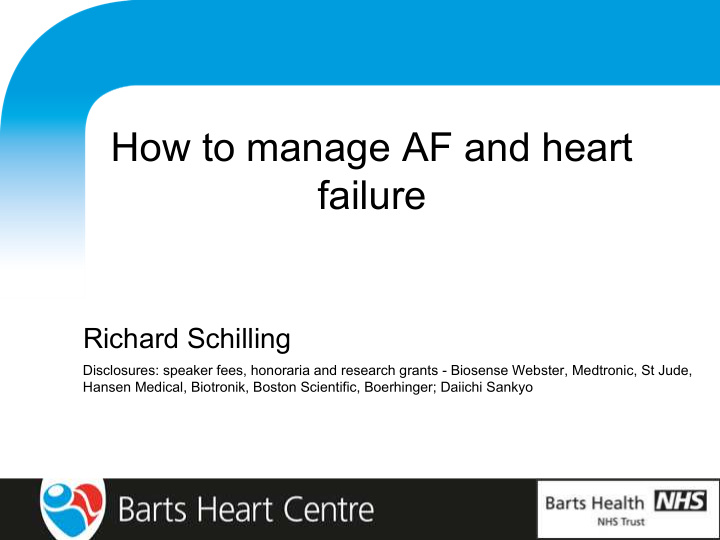



How to manage AF and heart failure Richard Schilling Disclosures: speaker fees, honoraria and research grants - Biosense Webster, Medtronic, St Jude, Hansen Medical, Biotronik, Boston Scientific, Boerhinger; Daiichi Sankyo
Classification of AF in heart failure • AF caused by heart failure • AF causing heart failure AF HF
Predictors of HF→AF • Similar to non HF patients Campbell et al. Int J Cardiol 2014
Natural history of HF→AF • 197 pts • no history of AF • EF 20-30% • Implanted devices capable of AF detection • 2 year follow up AF doesn't necessarily progress Even in heart failure Campbell et al. Int J Cardiol 2014
Heart failure caused by AF Rate related Ischaemia Ca handling Mechanical Inflammatory ↓LVED filling Neuroendocrine Beat to beat Sympathetic stimulation variation Pro-inflammatory state Abnormal ventricular function
Predictors of AF→HF • Less common than HF → AF • Poor rate control >110 bpm • AF can cause HF even when rate control is adequate
Management of AF and heart failure • Step 1 Stroke prevention and HF optimisation • Step 2 decide - rate control or rhythm control • Step 3 applying rate or rhythm control
Stroke prevention • Symptoms or type of AF do not predict risk Hart et al JACC 2000
Stroke prevention in HF • Bleeding risk - Identify reversible risk factors – Hypertension – Alcohol – Drugs (aspirin) • Renal dysfunction
Step 2 rate vs rhythm control • Rhythm control - no ↑prognosis/stroke risk in any RCT: – Rhythm control didn't work (drugs/cardioversion) – Anti arrhythmic drugs > risk than AF Van Gelder et al NEJM 2002 AFFIRM investigators NEJM 2002
Step 2 rate vs rhythm control • Analysis from Rocket AF • HF in 71% vs 41% vs 62% Steinberg et al Heart Rhythm 2015
Step 2 rate vs rhythm control • Two key questions – Is AF making symptoms worse? – Is AF causing heart failure?
Is AF making symptoms worse? • In PAF - do symptoms correlate with ECG? • In persistent AF what is the response to DC cardioversion on amiodarone?
DC cardioversion on amiodarone • Low risk • Amiodarone may help maintain SR • Patient can assess symptomatic benefit of SR • Patient then choses – Rate control – Rhythm control • Maintain amiodarone or catheter ablation
Step 2 rate vs rhythm control • Do symptoms get worse with AF? - no • Is the HF caused by AF? - no Rate control to <110 bpm
Rate control in HF • Beta-blocker or Ca 2+ -blocker • Additional digoxin • Personal preference - Ca 2+ -blocker > digoxin • CRT pacing +/- AV node ablation
Step 2 rate vs rhythm control • Do symptoms get worse with AF? - not sure • Is the HF caused by AF? - no Rate control Then if fails PAF correlate symptoms with ECG DC cardioversion on amiodarone
Step 2 rate vs rhythm control • Do symptoms get worse with AF? - yes • Is the HF caused by AF? - no Rate control to 80 bpm (symptoms not prognosis) If fails then Rhythm control
Step 2 rate vs rhythm control • Is the AF causing symptoms? - no or yes • Is the HF caused by AF? - yes Catheter ablation
AF ablation in HF N=50 pts RCT of persistent AF puts and EF<50% Optimal medical therapy for 1 month then randomised to continued rate control or ablation ablation (26) control (24) EF 31.8±7.7 33.7±12.1 co-diagnosis of AF 15 13 months of AF 24 24 Hunter et al. Circ EP 2014
AF ablation and HF with systolic dysfunction - outcome Hunter et al. Circ EP 2014
AF ablation and HF with systolic dysfunction - outcome Hunter et al. Circ EP 2014
Meta-analysis of AF ablation in HF • ↑ in EF with ablation • Mean 13.5% (95% CI 11-16%) Ganesan et al. Heart and Lung Circ 2015
Meta-analysis of AF and HF Anselemino et al. Circ AE 2014
Ablation success ↑ in pts with short history of AF/HF • Meta-analysis, n=1838 Time in AF and recurrence risk Time in HF and recurrence risk Anselemino et al. Circ AE 2014
Identifying AF causing HF ablation (26) control (24) Patients with 5 (25%) 0 normalisation EF co-diagnosis of AF 5 (100%) n/a If they had symptoms from AF then they Co-diagnosis of AF with heart failure was a would have been treated prior to HF powerful predictor of normalisation of LV 50% of pts have no AF symptoms function Hunter et al. Circ EP 2014
Identifying AF→ HF pts Patients with greatest response: 1. AF precedes or co-incident with HF 2. ECG normal other than AF 3. “Idiopathic” HF 4. No gad enhancement on MRI Patients with some responseAF precedes or co- incident with heart failure 1. Deterioration in QOL with AF, not improved by rate control
Who has the greatest chance of success • PAF 1 • Recent onset AF • LA size 2 1) Hunter et al Heart 2010 2) De Potter et al Europace 2010
AF ablation the outcome 38 male 2 week incr SOB then pulmonary oedema courtesy Dr Sam Mohiddin Barts Heart centre
AF ablation the outcome courtesy Dr Sam Mohiddin Barts Heart centre Before After
Practical management of AF heart failure patients Stroke prevention and HF treatment Catheter yes ablation Good ablation yes AF related candidate ? symptoms despite no Life long rate control amiodarone no no no HF before 2 o cause for HF? AF? Consider AV node yes yes ablation and CRT for Rate control failed rate or rhythm control
Conclusions • Close liaison between HF and EP team • Clear protocols for management of AF/HF • Prioritise stroke and heart failure meds • Do not delay progress along the AF path • Patient selection critical for best outcomes
Recommend
More recommend